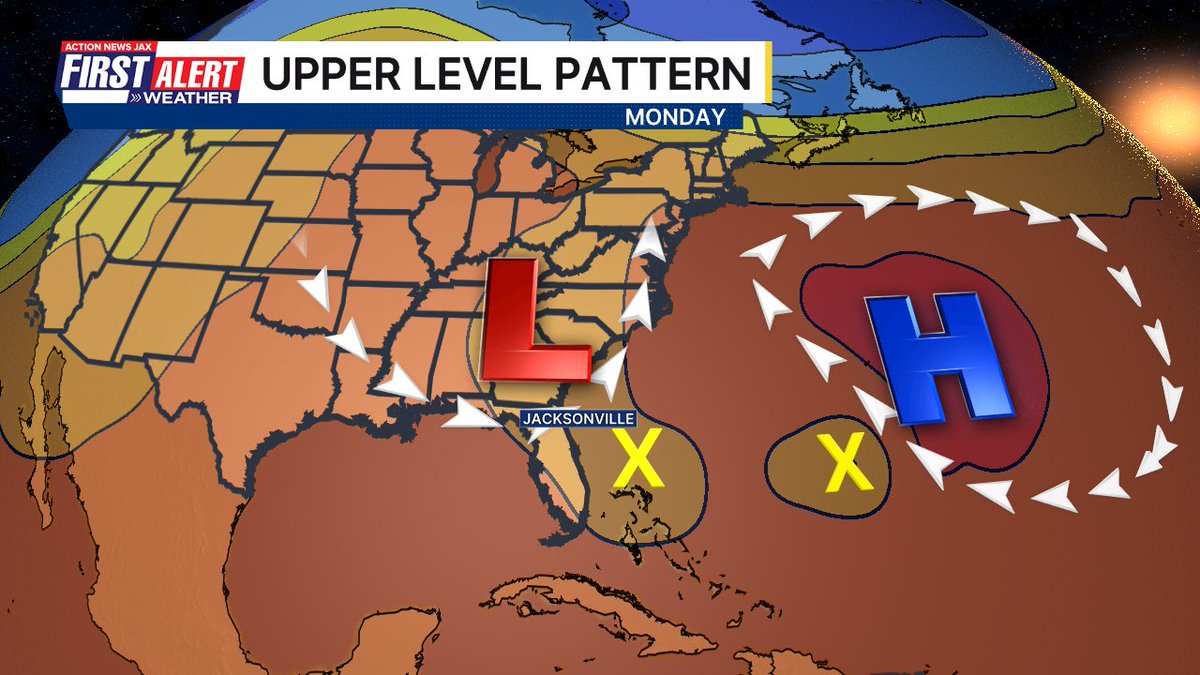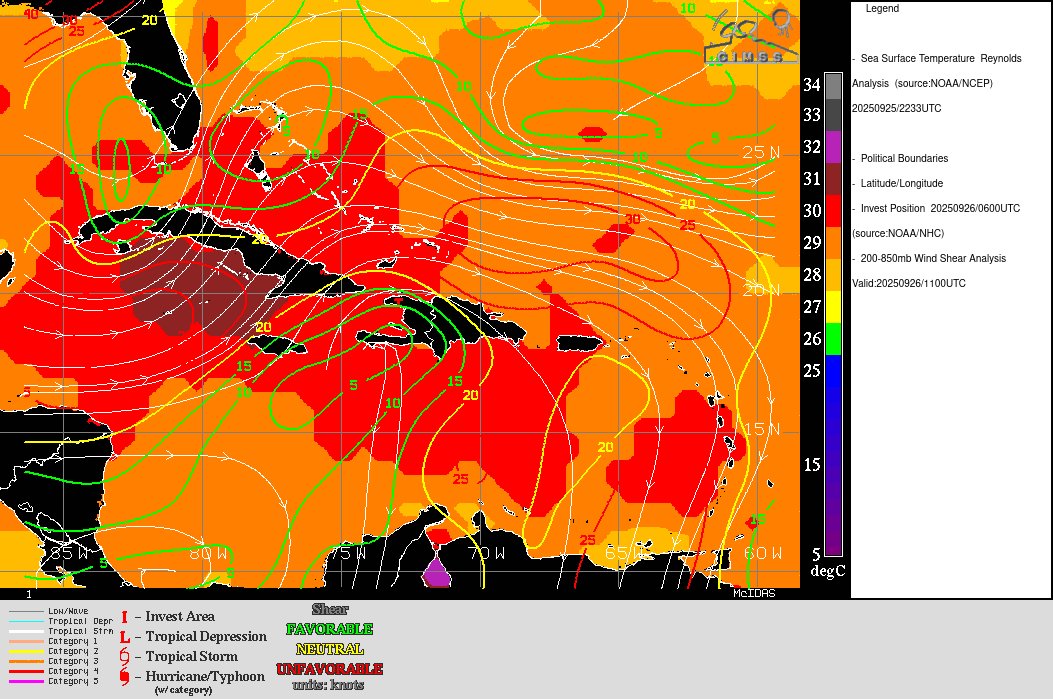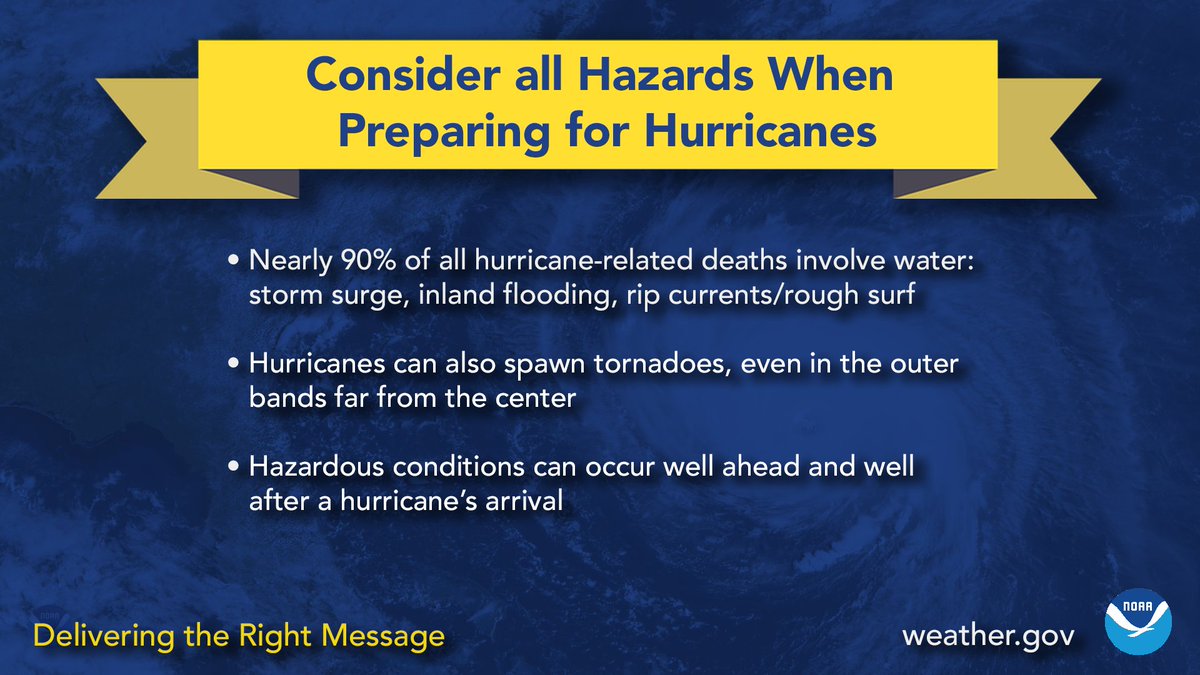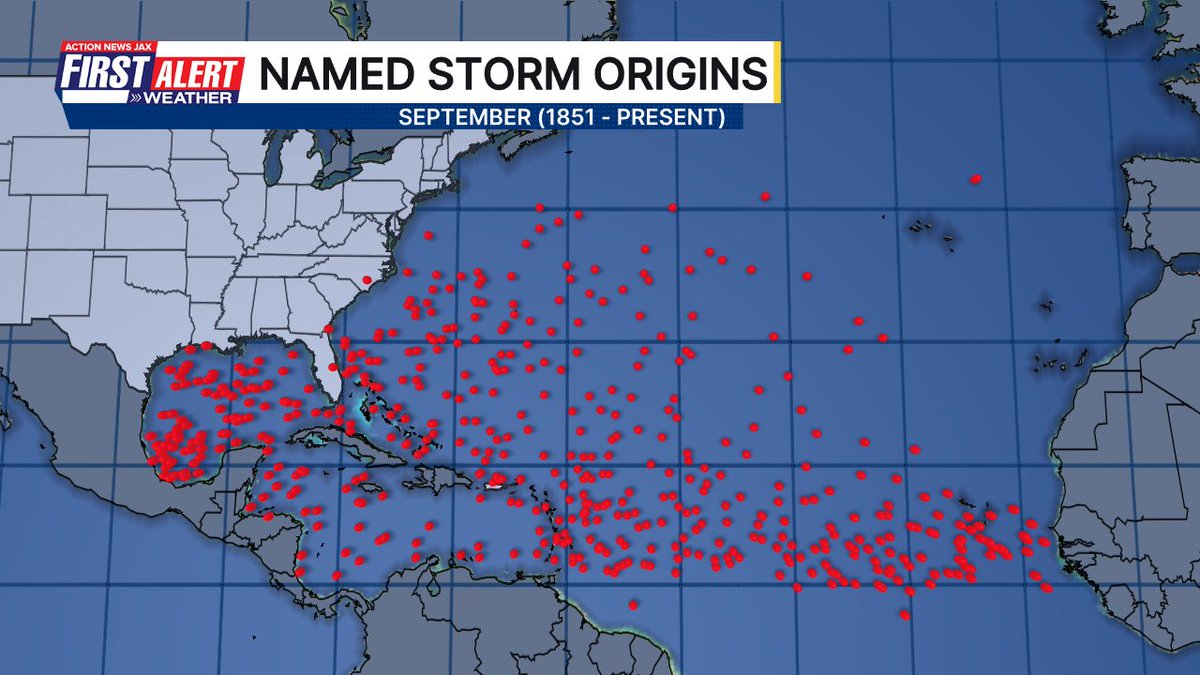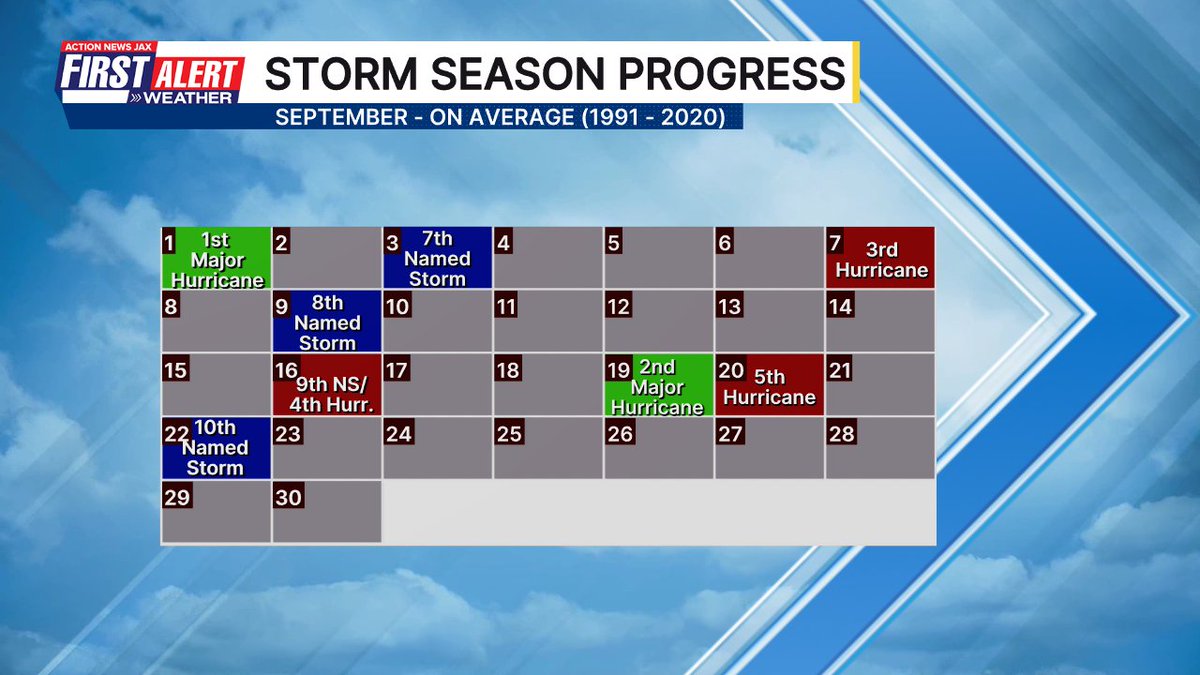Jacksonville, Fl. — THE TROPICS:
***** ALWAYS CHECK & RE-CHECK THE LATEST FORECAST & UPDATES! ****
Tropics threats/impacts for Jacksonville/NE Florida/SE Georgia: None through Saturday but an increasing risk for rip currents & rough seas & surf by late Sunday into next week. Gusty winds are possible too - any & all impacts dependent on possible development of the tropical wave moving into the Bahamas over the weekend - + the system’s (may be “Imelda”) location & intensity relative to the local coast. Virtually no inland impacts are expected for NE Fl./SE Ga.
The Atlantic Basin Overview:
The Atlantic hurricane season is June 1st through Nov. 30th.
Attention continues to be focused primarily on ‘94-L’ which has poured on Puerto Rico & Hispaniola the last few days while Humberto intensifies to its east over the Central Atlantic. Recent indications & model output indicate the two systems - ‘94-L’ & Humberto - will mostly remain separate outside of perhaps some impacts due to outflow from either or both systems. But true interaction/interplay seems unlikely. How exactly these systems move - especially 94-L - will be largely modulated by an upper level trough over the Eastern U.S. This trough could either sling-shot 94-L to the west & into the U.S. east coast from Ga. to the Carolina’s or swing the disturbance more out to the east & somewhere in-between with a stall near or just off the coast. It will be a while yet before this complicated steering pattern becomes well established & more predictable. NOAA & the N.W.S. are trying to help out the forecast models by launching extra weather balloons from Florida to the Mid-Atlantic into the weekend (including Jacksonville N.W.S.) as well as special hurricane recon missions to sample the weather environment over & near the Caribbean & Southwest Atlantic.
Folks from the Caribbean to the Bahamas to the U.S. east coast to eventually Bermuda need to stay up to date on the latest forecasts.
The 500mb (approx 30,000 feet) European forecast for Monday, Sept. 29:
(1) ‘94-L’ is slowly moving away from Hispaniola & seems to be gradually organizing as it moves away from the mountainous terrain & shear slowly relaxes. This wave will move northwest (has been trending more west the last couple of days but the turn north should begin soon) & has the *potential* for U.S. impacts as early as Sunday night/Monday. As the wave progresses northwest then northward, the combination of less shear & very warm ocean water should allow for strengthening. The upper level trough to the west may also help ventilate the system in the upper levels helping to make conditions even more favorable for strengthening.
The system is *currently* projected to move east of Florida early next week prior to a more significant turn northwest toward the coast then move north/northwest & may impact the eastern seaboard from Georgia & the Carolina’s to the Mid-Atlantic by the middle of next week. It is quite possible the disturbance may stall very near the coast or even meander or loop. Such a possibility raises the specter of extremely heavy rainfall & the potential for major flooding for especially parts of the Carolina’s & possibly as far north as Virginia.
The exact track will be dictated by the upper level trough moving into the Eastern U.S. over the weekend/early next week with a potential closed/cut-off low that may capture this wave drawing it counter-clockwise west/northwest. And there is that possibility the upper trough will not fully capture the potential tropical cyclone leaving it to swirl near or just off the east coast but very near the warm Gulf Stream. Forecast models range from a strong move inland (GFS)... to staying near the coast/meandering/looping (European)... to a near miss to the east (Canadian)... to the Google DeepMind model which is not very bullish at all & seems to be confused at times with the much more well developed Humberto & its very low pressure to the east.
In the end there may not be much time to prepare once this disturbance shows its hand & begins to strengthen & approach landfall.
This remains an exceedingly difficult forecast right now & there will have to be updates in the days ahead. At the very least it does look like rough seas & surf for NE Fl. & SE Ga. with a high rip current risk which may spread up the eastern seaboard as far north as Virginia. A hurricane hit somewhere on the Southeast U.S. coast is *possible* currently centering on the Carolina’s.
(2) ‘93-L’ was upgraded to “Humberto” Wed. afternoon & became a hurricane early Friday. Humberto will follow in the wake of Gabrielle but a little more west (closer to Erin’s track last month) which could mean at least some threat to Bermuda next week. Conditions look quite favorable for Humberto to be a powerful Cat. 3+ hurricane into next week, but it will stay well east of the U.S. There is some chance for some interaction - competing outflow in particular - with 94-L to the west though it appears there should be just enough separation to keep the two systems as their own entities. Humberto will move slowly into early next week over the Central & Western Atlantic before finally turning more sharply to the northeast & accelerating by the middle to late part of next week.

Very warm water & lower shear values once ‘94-L’ moves away from Hispaniola:
7-Day rainfall forecast:




Satellite microwave imagery from CIMSS:


Also of interest in trying to forecast ‘94-L’ is a possible typhoon teleconnection. “Bualoi” will move west/northwest then turn more northwest while moving into Vietnam over the next few days. This movement is due to a pretty strong upper level trough well to the west over China edging southward to the west of Vietnam. I’m thinking that perhaps the forecast models - especially earlier this week - were too far east with the U.S. trough given what’s going on over the W. Pacific. Similarly - also underplaying the strength & positioning of the Bermuda High over the Eastern Atlantic. Since Wed., we have seen the forecast models shift west with ‘94-L’ perhaps due to the upper level trough being more to the west vs. earlier forecasts. This has major implications on where 94-L tracks.

Tropical wave ‘92-L’ was upgraded to tropical depression #7 early last Wed. over the Central Atlantic & was then upgraded to tropical storm Gabrielle later Wed. morning & intensified into a hurricane Sunday afternoon peaking at Cat. 4 intensity Monday through early Tue. of this week... then became a powerful post-tropical low while moving through the islands of the Azores.
Gabrielle’s low pressure area will slowly wind down while approaching Portugal through the weekend.



‘Velocity potential anomalies’ below. shows “Rising” air (green lines) equates with an uptick in overall convection. With rising air, conditions are generally more favorable for tropical development. Where there are brown lines, the air is generally sinking & is often less conducive to tropical cyclones (though not impossible to have development).

The “Buresh Bottom Line”: Always be prepared!.....First Alert Hurricane Preparation Guide... City of Jacksonville Preparedness Guide... Georgia Hurricane Guide.
STAY INFORMED: Get the * FREE * First Alert Weather app
FREE NEWS UPDATES, ALERTS: Action News Jax app for Apple | For Android
WATCH “Preparing for the Storm”
WATCH “The Ins & Outs of Hurricane Season”
READ the First Alert Hurricane Center “Preparation Guide”
LISTEN “First Alert Weather: Preparing for the Storm”
Federal Alliance for Safe Homes (FLASH) * here *.
REMEMBER WHEN A TROPICAL STORM OR HURRICANE IS APPROACHING: Taping windows is *not* recommended & will not keep glass from breaking. Instead close curtains & blinds.
Realize the forecast cone (”cone of uncertainty”) is the average forecast error over a given time - out to 6 days - & *does not* indicate the width of the storm &/or where damage might occur.
The map below shows the *average* time for a tropical wave coming off Africa to travel west & northwest. Only about 1 in 5 tropical waves - on average - become a tropical cyclone of some sort (depression/storm/hurricane):






Water vapor loop (dark blue/yellow is dry mid & upper level air):

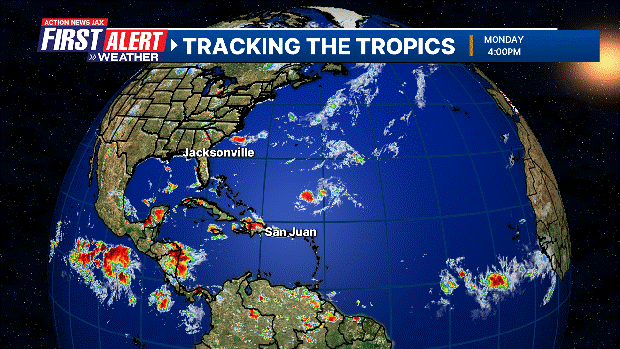
September Atlantic tropical cyclone origins:
Averages below based on climatology for the Atlantic Basin for September:
Wind shear (red - strong shear; green - low shear). Shear is typically strong to start the hurricane season:




Saharan dust spreads west each year from Africa driven by the prevailing winds (from east to west over the Atlantic). Dry air = yellow/orange/red/pink. Widespread dust is indicative of dry air that *can* interfere with the development of tropical cyclones. However, sometimes “wanna’ be” waves will just wait until they get to the other side of - or away from - the dust plume then try to develop if other conditions are favorable (we saw this with Beryl & Debby last year). It’s my personal opinion that there is way too much “hoopla” about the presence of Saharan dust & how it relates to tropical cyclones. In any case, the peak of Saharan dust typically is in June & July, & we are indeed seeing a large “blobs” of Saharan dust over the Central & Eastern Atlantic that’s thinning with westward extent but enough of it to make for hazy skies across the Caribbean & - at times - across parts of Florida.
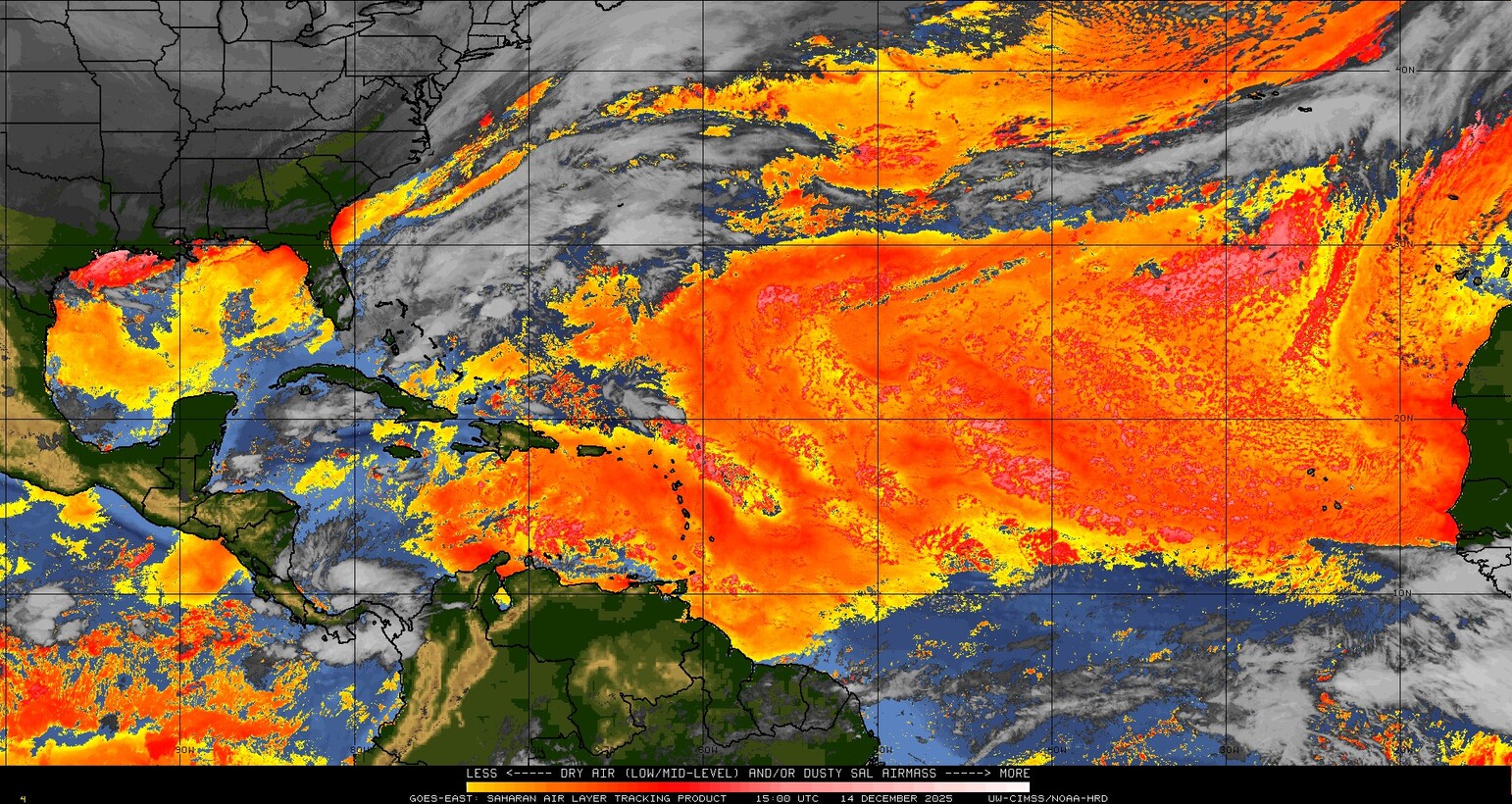
2025 names..... “Imelda” is the next name on the Atlantic list (names are picked at random by the World Meteorological Organization... repeat every 6 years). Historic storms are retired [Florence & Michael in ’18... Dorian in ’19 (the last time this year’s list was used) ... Laura, Eta & Iota in ‘20 ... Ida in ‘21 ... Fiona & Ian in ‘22... no names were retired in ‘23 for the first time since 2014... & Beryl, Helene & Milton last year in 2024]). The WMO decided - beginning in 2021 - that the Greek alphabet will be no longer used & instead there will be a supplemental list of names if the first list is exhausted (has only happened three times - 2005, 2020 & 2021). The naming of tropical cyclones began on a consistent basis in 1953. More on the history of naming tropical cyclones * here *.

Hurricane season climatology:
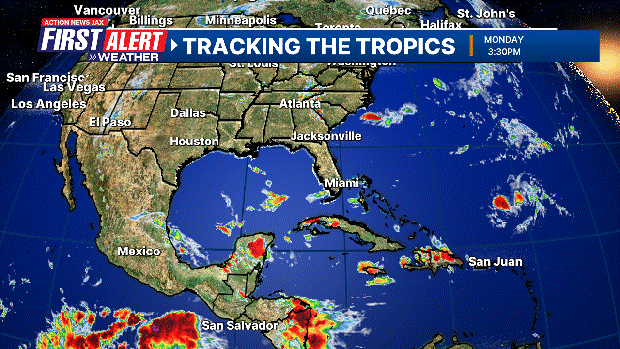



East Atlantic:




Mid & upper level wind shear (enemy of tropical cyclones) analysis (CIMMS). The red lines indicate strong shear:
Water vapor imagery (dark blue indicates dry air):

Deep oceanic heat content over the Gulf, Caribbean & tropical Atlantic. The colors will brighten greatly as the water warms to greater depths deeper into the season. It’s worth noting that the deep oceanic heat content right now is not as high as this time last year.

Sea surface temps.:

Sea surface temp. anomalies:

SE U.S. surface map:

Surface analysis centered on the tropical Atlantic:

Surface analysis of the Gulf:

Caribbean:

Atlantic Basin wave period forecast for 24, 48, 72 & 96 hours respectively:





This past spring I visited the west coast of Florida - from Cedar Key to Tampa Bay - to see how the area is recovering from the very rough ‘24 hurricane season namely Helene & Milton:
East & Central Pacific:
“Narda”:





Central Pacific:

Hawaii satellite imagery:


West Pacific:
Global tropical activity:
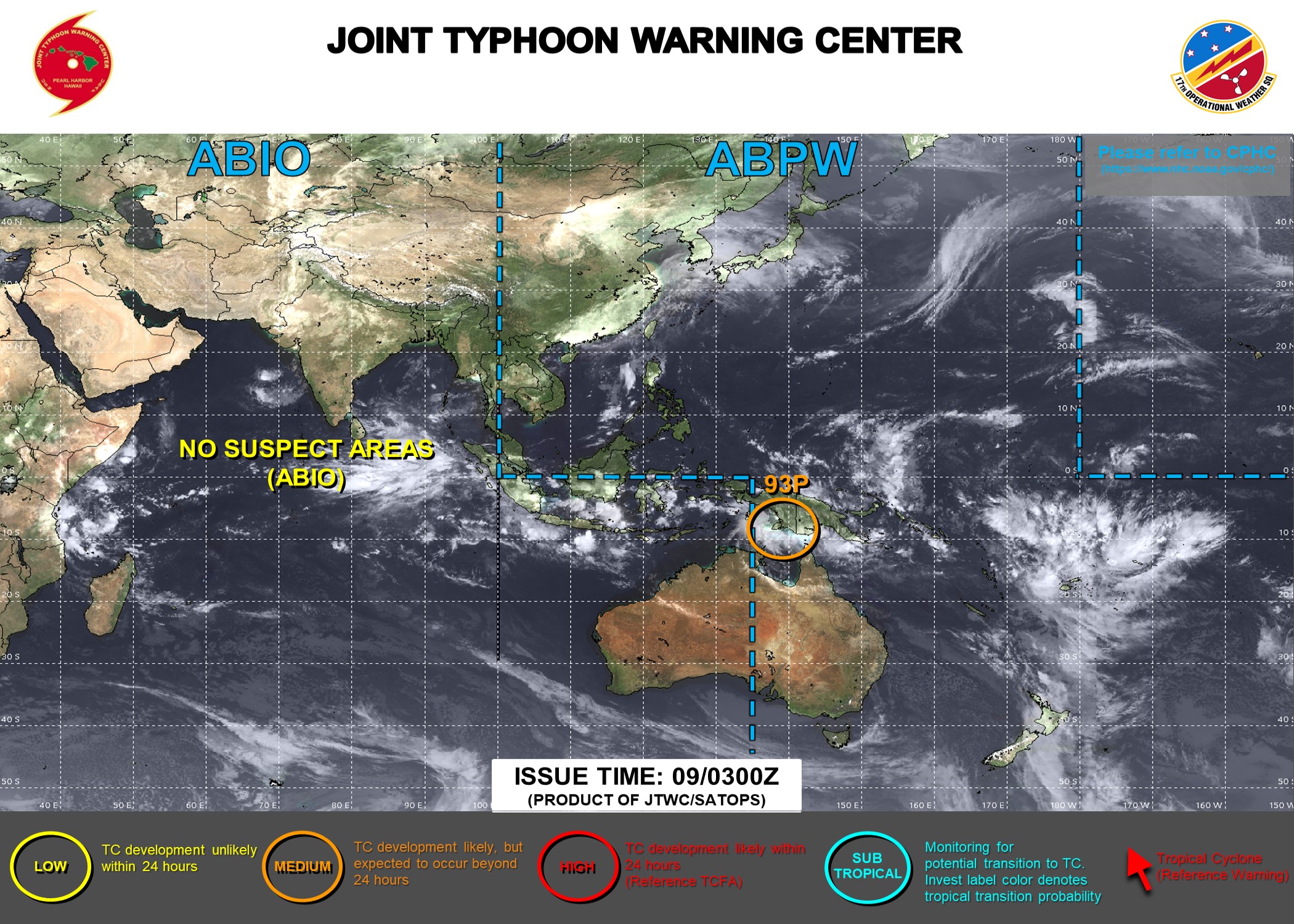
“Bualoi” will move through the middle of the Philippines:

“Neoguri” is crawling & is expected to stay east of Japan:
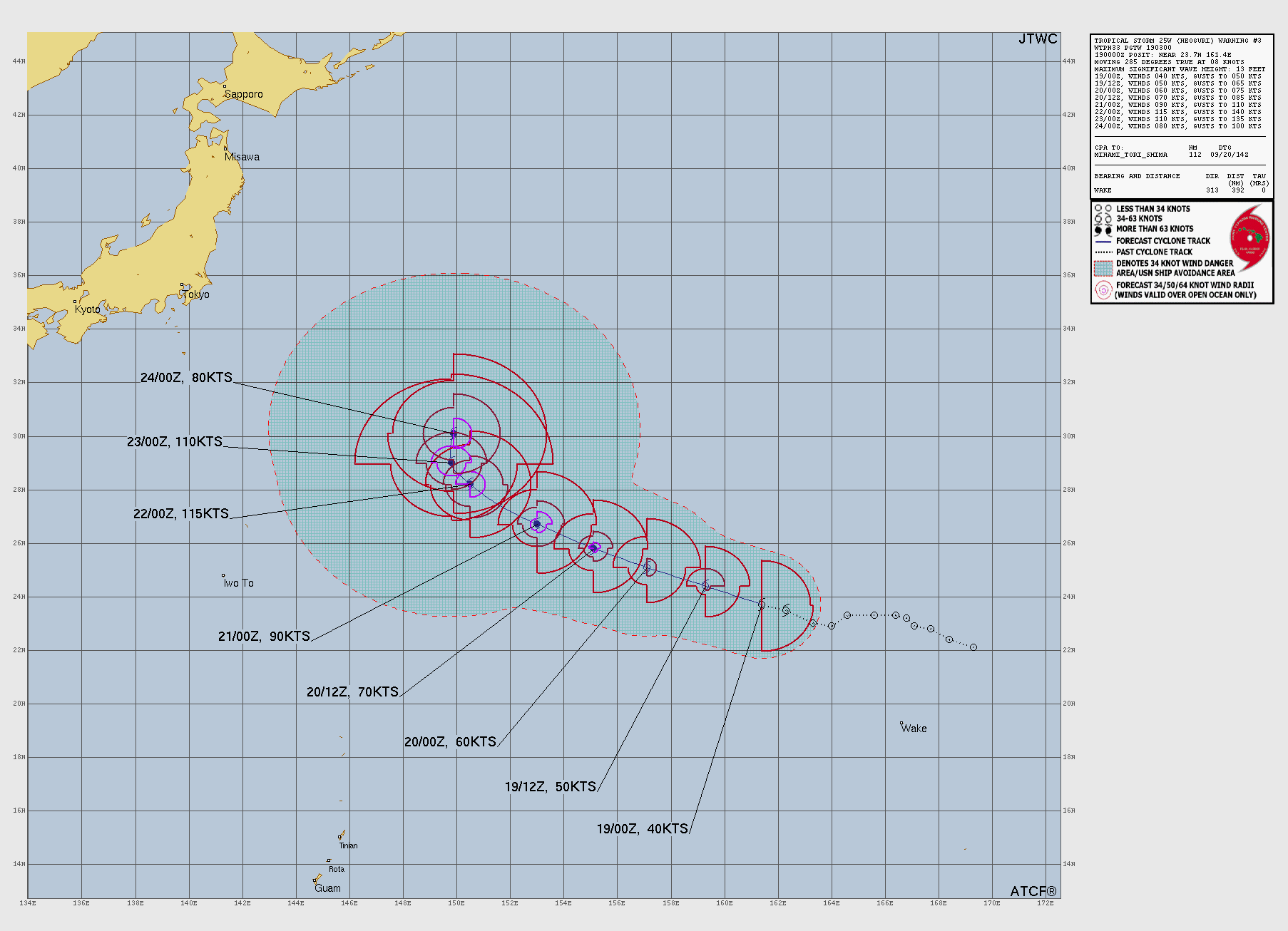
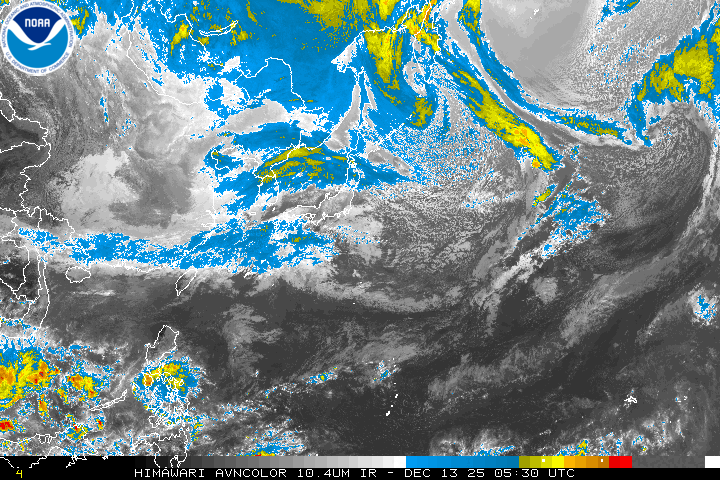


Cox Media Group


